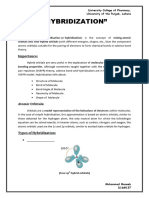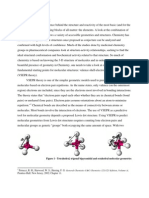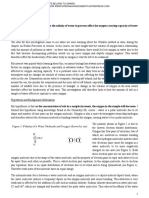Stacking in Non-Aromatic Molecules (Hydrogen-Bridged) : Anand Kamal
Uploaded by
Sundar SinghStacking in Non-Aromatic Molecules (Hydrogen-Bridged) : Anand Kamal
Uploaded by
Sundar SinghStacking in non-aromatic
molecules (Hydrogen-bridged)
Anand Kamal
Intermolecular stacking between planar five-membered hydrogen bridged
ring having strong interactions leads to high energy, is alternative of aromatic
stacking, and useful in material design and biochemistry.
Supramolecular chemistry, biochemistry have very important role in our daily life. Likewise stacking
in aromatic molecules it is also seen in planar rings. We have already learned about intramolecular
hydrogen bonding in acyclic systems. First time in this article they have studied through Cambridge
Structural Database (CSD) and using quantum chemical calculations about interactions of five-
membered hydrogen bridged rings that contains single bonded planar atoms. Now the five
membered rings has donor (D), acceptor (A) and hydrogen atom in between them during their
search through CSD they followed some constraints such as
Distance between A and D atoms must be less than 4.0 .
Angle between D, H and A should be in range of 90 to 180 degrees.
N, O, S, F and Cl can be donor or acceptor atoms because of their electronegativity.
All bonds within ring must be single.
All atoms in ring were planar (non-planar atoms excluded).
Two centroids having distance 4.5A or less are said to have intermolecular interactions.
Out of 978 rings 307 are found to be have distance between centroids less than 4.5 A, while 264
forms parallel interactions. Stacking in aromatic rings is near about (3-4 A), and that of single bonded
planar rings is (3.0-3.5 A) indicate some similarity between two.
For the calculation of the strength of the interaction between two stacked hydrogen bridged rings
that are in antiparallel position optimization of monomers are done using MP2/cc-pVTZ level.
Stacking interaction energies between two rings is calculated using CCSD (T)/CBS method.
Interaction energy is defined as difference between the dimer energy and the sum of energies of
monomers. Molecules in first move along (O-C) direction where O represents centroid of molecule
and C represents centroid of hydrogen acceptor bond. In another, molecules can move orthogonal
to (O-C) direction. For both potential curves are made using DFT methods. In potential curves the
minima is obtained along O-C direction for 0A (means rings are perpendicularly above each other),
and there energy difference is slightly less. For orthogonal case minima on potential curve is at offset
of -1.0A while strongest interactions at offset of 2.5A which is for doubly bonded methylidene group
.These strong interaction shows the importance of parallel interactions of hydrogen bridged rings
and proves that parallel alignment is not enough for crystal packing.
This was all that was researched about stacking in non-aromatic hydrogen bridged rings.
You might also like
- Calculate Effective No of Atom, Packing Factor EtcNo ratings yetCalculate Effective No of Atom, Packing Factor Etc7 pages
- Bonding Patterns in Transition Metal Clusters: A. CeulemansNo ratings yetBonding Patterns in Transition Metal Clusters: A. Ceulemans8 pages
- Биоорганическая химия для студентов-медиков = Bioorganic chemistry for medicalNo ratings yetБиоорганическая химия для студентов-медиков = Bioorganic chemistry for medical144 pages
- Pastpaper InOrganicChemistry SQs Solved 6th Sem (2014-24) - by Haseeb Ahmad (Revised Edition)No ratings yetPastpaper InOrganicChemistry SQs Solved 6th Sem (2014-24) - by Haseeb Ahmad (Revised Edition)28 pages
- VND Openxmlformats-Officedocument PresentationmlNo ratings yetVND Openxmlformats-Officedocument Presentationml56 pages
- Chm 101 -Hybridization and Shapes of MoleculesNo ratings yetChm 101 -Hybridization and Shapes of Molecules12 pages
- TO Organic Chemistry: Group: A: Assoc. Prof. Dr. Saripah Salbiah100% (1)TO Organic Chemistry: Group: A: Assoc. Prof. Dr. Saripah Salbiah47 pages
- 6.03 Electronic Structure of Complexes (Part 2)No ratings yet6.03 Electronic Structure of Complexes (Part 2)6 pages
- Structure and Bonding in Organic CompoundsNo ratings yetStructure and Bonding in Organic Compounds36 pages
- Cream and Green Illustrative Science Project Presentation_20241028_132120_0000No ratings yetCream and Green Illustrative Science Project Presentation_20241028_132120_000022 pages
- 2023 Chemical Bonding and Molecular Structure - 2No ratings yet2023 Chemical Bonding and Molecular Structure - 210 pages
- Course 201N 1 Semester 2006-2007 Inorganic Chemistry Instructor: Jitendra K. BeraNo ratings yetCourse 201N 1 Semester 2006-2007 Inorganic Chemistry Instructor: Jitendra K. Bera11 pages
- Introductory Chemistry Atoms First 5th Edition Russo Solutions Manual 1100% (81)Introductory Chemistry Atoms First 5th Edition Russo Solutions Manual 127 pages
- 05 Molecular Geometry and Bonding TheoriesNo ratings yet05 Molecular Geometry and Bonding Theories16 pages
- Additional Questions of Chemical Bonding - 18290360 - 2023 - 06 - 20 - 12 - 13No ratings yetAdditional Questions of Chemical Bonding - 18290360 - 2023 - 06 - 20 - 12 - 135 pages
- Chemical Bonding and Molecular StructureNo ratings yetChemical Bonding and Molecular Structure17 pages
- Conformations of Cyclic and Acyclic Molecules-1No ratings yetConformations of Cyclic and Acyclic Molecules-116 pages
- Fundamentals of Cost Analysis For Decision MakingNo ratings yetFundamentals of Cost Analysis For Decision Making30 pages
- ESC101: Fundamental of Computing: End Semester Exam 19 November 2008No ratings yetESC101: Fundamental of Computing: End Semester Exam 19 November 20089 pages
- Matlab Workbook: CME 102 Winter 2008-2009No ratings yetMatlab Workbook: CME 102 Winter 2008-200955 pages
- Subject: Request For Dropping CHM402A-ORGANIC CHEMISTRY-IINo ratings yetSubject: Request For Dropping CHM402A-ORGANIC CHEMISTRY-II1 page
- Weekly Programming Challenge 1: Next PalindromeNo ratings yetWeekly Programming Challenge 1: Next Palindrome1 page
- Applied Chemistry Suggestion (2023-24)No ratings yetApplied Chemistry Suggestion (2023-24)44 pages
- Chapter 5 Chemistry of Engineering MaterialsNo ratings yetChapter 5 Chemistry of Engineering Materials36 pages
- Mathematics: Syllabus For TS EAMCET 2022-E Stream (Engineering Stream)No ratings yetMathematics: Syllabus For TS EAMCET 2022-E Stream (Engineering Stream)27 pages
- Module 5n6 Answer Sheet Is Anatomy and Physiology (Abegail C. Relunia - Bsed 3c-Science)No ratings yetModule 5n6 Answer Sheet Is Anatomy and Physiology (Abegail C. Relunia - Bsed 3c-Science)6 pages
- UNIT-1: Chemistry Questions Ans Answers Based On High Order Thinking Skill (Hots)No ratings yetUNIT-1: Chemistry Questions Ans Answers Based On High Order Thinking Skill (Hots)5 pages
- Inorganic Chemistry Chemical Bonding question bankNo ratings yetInorganic Chemistry Chemical Bonding question bank43 pages
- CLS Aipmt-17-18 XI Che Study-Package-3 SET-2 Chapter-11No ratings yetCLS Aipmt-17-18 XI Che Study-Package-3 SET-2 Chapter-1121 pages
- Instant Download (Ebook PDF) Chemistry: The Molecular Nature of Matter, 7th Edition PDF All Chapter100% (3)Instant Download (Ebook PDF) Chemistry: The Molecular Nature of Matter, 7th Edition PDF All Chapter49 pages
- Structure of The Atom and The Periodic Table Chemistry Form 2 Topical Questions and AnswersNo ratings yetStructure of The Atom and The Periodic Table Chemistry Form 2 Topical Questions and Answers27 pages
- The Metal Based Catalysts For Selective Hydrogenation of Anthraquinone To Produce Hydrogen Peroxide100% (1)The Metal Based Catalysts For Selective Hydrogenation of Anthraquinone To Produce Hydrogen Peroxide17 pages
- R B Woodward - A Total Synthesis of Colchicine - Harvey Lecture 1963No ratings yetR B Woodward - A Total Synthesis of Colchicine - Harvey Lecture 196317 pages
- +2 Chemistry Second Term Exam Dec 2024-Answer Key_hssreporter•com (1)No ratings yet+2 Chemistry Second Term Exam Dec 2024-Answer Key_hssreporter•com (1)6 pages
- Practice Test I (Basic Science) - SolvedNo ratings yetPractice Test I (Basic Science) - Solved18 pages








































































































